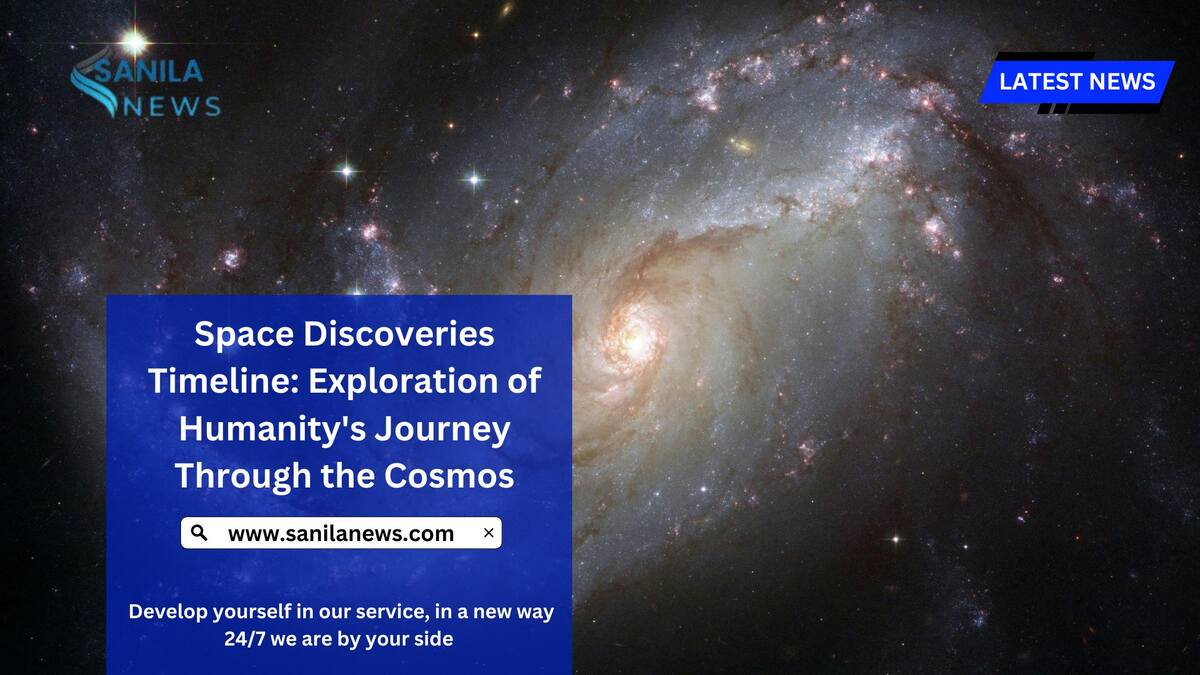Space Discoveries Timeline: Exploration of Humanity’s Journey Through the Cosmos
Human curiosity about space has led to countless discoveries, each building on previous knowledge and pushing the boundaries of science. From ancient astronomers observing the skies with the naked eye to modern-day space telescopes sending back images of distant galaxies, our understanding of the cosmos has evolved significantly. This timeline highlights key space discoveries and milestones that have shaped our exploration of the universe.
Space discoveries timeline Ancient Space Discoveries (Pre-1600s)
- Babylonian and Egyptian Astronomy (2000 BCE – 1000 BCE)
- The ancient Babylonians and Egyptians were some of the first to document celestial movements. They recorded the positions of stars, planets, and constellations to create calendars and predict celestial events such as eclipses.
- Key Discoveries: The Egyptians aligned the Pyramids of Giza with specific stars, while the Babylonians developed an early form of the zodiac based on the movement of the sun through the constellations.
- Aristotle and the Geocentric Model (4th Century BCE)
- Greek philosopher Aristotle proposed a geocentric model of the universe, where Earth was at the center, and all celestial bodies (the moon, sun, planets, and stars) revolved around it.
- This Earth-centered model was widely accepted for over a millennium and influenced later astronomers like Ptolemy, who refined it in the 2nd century CE.
- Ptolemy’s Almagest (150 CE)
- Claudius Ptolemy published the Almagest, a comprehensive astronomical treatise that detailed the geocentric model and the movements of the planets. He introduced the idea of epicycles (small circular orbits within larger ones) to explain the apparent retrograde motion of planets.
- Copernican Revolution (1543)
- In the 16th century, Nicolaus Copernicus challenged the geocentric model with his heliocentric theory. In his book De Revolutionibus Orbium Coelestium, Copernicus proposed that the Earth and other planets revolved around the sun.
- Although it took decades for his ideas to gain widespread acceptance, the heliocentric model marked a major shift in our understanding of the universe.
The Renaissance and Early Modern Discoveries (1600s – 1800s)
- Galileo and the Telescope (1609)
- Galileo Galilei revolutionized astronomy by using a telescope to observe the heavens. His discoveries included:
- Moons of Jupiter: He observed four large moons (Io, Europa, Ganymede, and Callisto) orbiting Jupiter, proving that not all celestial bodies revolved around the Earth.
- Phases of Venus: He observed that Venus went through phases similar to the moon, which provided strong evidence for the heliocentric model.
- Surface of the Moon: Galileo discovered that the moon had mountains and craters, challenging the belief that celestial bodies were perfect spheres.
- Kepler’s Laws of Planetary Motion (1609–1619)
- Johannes Kepler, using data from astronomer Tycho Brahe, formulated three laws that describe the motion of planets around the sun:
- First Law (1609): Planets move in elliptical orbits with the sun at one focus.
- Second Law (1609): A planet sweeps out equal areas in equal times, meaning that planets move faster when closer to the sun and slower when farther away.
- Third Law (1619): The square of a planet’s orbital period is proportional to the cube of the semi-major axis of its orbit.
- Newton’s Law of Universal Gravitation (1687)
- In his work Philosophiæ Naturalis Principia Mathematica, Isaac Newton formulated the law of universal gravitation, which explained how celestial bodies are held in orbit by gravity. This unified understanding of motion in the heavens and on Earth paved the way for further space exploration.
- Discovery of Uranus (1781)
- William Herschel discovered Uranus, the first planet to be identified with a telescope. Before this discovery, only five planets (Mercury, Venus, Mars, Jupiter, and Saturn) were known.
- Uranus’ discovery expanded the known boundaries of our solar system and led to the search for more distant planets.
- Discovery of Neptune (1846)
- Using mathematical predictions based on irregularities in Uranus’ orbit, astronomers Urbain Le Verrier and Johann Galle discovered Neptune.
- This was the first planet to be discovered through mathematical prediction rather than direct observation.
- Hubble’s Discovery of the Expanding Universe (1920s)
- Edwin Hubble observed that galaxies were moving away from each other, leading to the groundbreaking discovery that the universe is expanding.
- Hubble’s observations of redshifts in distant galaxies provided the first evidence supporting the Big Bang theory, which proposes that the universe began from a single point and has been expanding ever since.
Space discoveries timeline The Space Age (1950s – 1970s)
- Launch of Sputnik (1957)
- The Space Age officially began on October 4, 1957, when the Soviet Union launched Sputnik 1, the first artificial satellite, into orbit. This milestone marked humanity’s first step toward space exploration and sparked the Space Race between the United States and the Soviet Union.
- First Human in Space: Yuri Gagarin (1961)
- On April 12, 1961, Soviet cosmonaut Yuri Gagarin became the first human to orbit the Earth aboard the Vostok 1 spacecraft.
- Gagarin’s successful mission demonstrated the feasibility of human spaceflight and pushed the boundaries of what was possible in space exploration.
- Apollo 11 Moon Landing (1969)
- On July 20, 1969, NASA’s Apollo 11 mission achieved one of the greatest milestones in human history when Neil Armstrong and Buzz Aldrin became the first humans to walk on the moon.
- Armstrong’s famous words, “That’s one small step for [a] man, one giant leap for mankind,” symbolized the culmination of years of effort and exploration.
- Mariner 4 and the First Images of Mars (1965)
- Mariner 4, a NASA spacecraft, was the first to fly by Mars and send back images of another planet. The black-and-white images of Mars’ surface revealed a barren, cratered landscape and marked the beginning of robotic exploration of other planets.
- Voyager Missions (1977)
- NASA launched the Voyager 1 and Voyager 2 probes to explore the outer planets and beyond. These spacecraft provided unprecedented close-up images and data from Jupiter, Saturn, Uranus, and Neptune.
- Voyager 1 became the first human-made object to enter interstellar space in 2012, continuing to send back data from the outer reaches of our solar system.
Modern Space Discoveries (1980s – Present)
- Hubble Space Telescope (1990)
- Launched in 1990, the Hubble Space Telescope revolutionized our understanding of the universe by providing high-resolution images of distant galaxies, nebulae, and stars.
- Hubble’s discoveries include detailed observations of black holes, the discovery of dark energy, and the most distant galaxies ever observed.
- Discovery of Exoplanets (1990s–Present)
- In 1992, astronomers discovered the first exoplanets (planets outside our solar system) orbiting a pulsar. In 1995, the first exoplanet orbiting a sun-like star, 51 Pegasi b, was found.
- Since then, thousands of exoplanets have been discovered, some of which reside in the habitable zone of their stars, where conditions might be suitable for life.
- Space discoveries timeline International Space Station (1998)
- The construction of the International Space Station (ISS) began in 1998, marking a new era of international collaboration in space. The ISS serves as a laboratory for scientific research and technological development, helping humans understand the effects of long-term space travel.
- Pluto and the New Horizons Mission (2015)
- NASA’s New Horizons spacecraft flew by Pluto in 2015, sending back detailed images and data of the dwarf planet’s surface and moons.
- This mission provided the first close-up look at Pluto, revealing unexpected features such as ice mountains and smooth plains.
- Space discoveries timeline Gravitational Waves Detected (2015)
- In 2015, scientists detected gravitational waves for the first time, confirming a key prediction of Albert Einstein’s general theory of relativity.
- Gravitational waves are ripples in space-time caused by the merging of massive objects, such as black holes. Their detection opened a new way of observing the universe.
21. First Image of a Black Hole (2019)
- In April 2019, scientists captured the first-ever image of a black hole using the Event Horizon Telescope. The image showed the shadow of the super
Read More:

